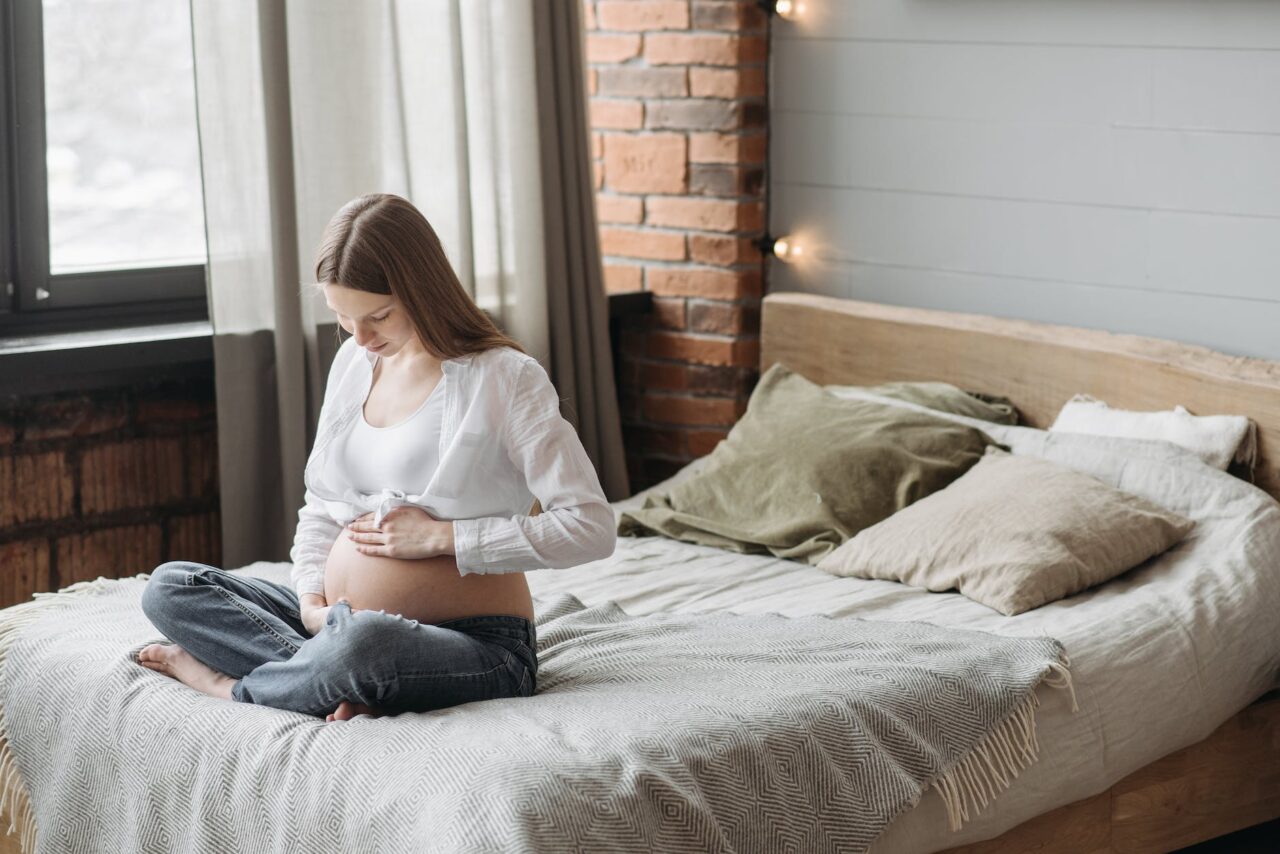The third trimester of pregnancy brings with it a myriad of sleep-related changes and struggles. If your Zzzzz’s are being disturbed by insomnia, frequent trips to the loo and an uncomfortable burning sensation in your chest, you’re not alone.
New research from sleep technology firm Simba reveals almost two thirds [60%] of expectant mums have been kept awake at night by heartburn and indigestion during pregnancy, particularly in the second and third trimesters.
While 65% of prenatal parents experienced a notable rise in nocturnal leg cramps during the final phase, making sleep more elusive.
The good news is, there are ways to improve your sleep quality if you are experiencing difficulties during the later stages of pregnancy.
Lisa Artis, deputy CEO at sleep tech firm Simba’s charity partner, The Sleep Charity, takes a look at the influencing factors and sheds light on how to sleep better during your third trimester.
8 ways to sleep better when you’re 8 months pregnant

1. Back and Belly Pain
6 in 10 prenatal mums report increased lower back pain, sore and aching muscles during the later stages of pregnancy according to Simba’s new data, which in turn causes sleep disturbances.
Higher levels of progesterone during pregnancy relax the muscles and joints to accommodate the growing uterus and enhance flexibility in your pelvis so the baby can pass through the birth canal more easily. But this can cause pain.
Your posture can also take a bit of a hit during the third trimester. You may find yourself leaning more to one side, which can exacerbate lower back and hip pain.
“The right sleep set-up can make all the difference during pregnancy”, says Lisa. “A responsive mattress that allows cooling airflow and provides good spinal, pelvic, and bump support. An adjustable pillow, and breathable, cotton sheets and bedding can help regulate a warmer body temperature.”
Simba mattresses benefit from edge-to-edge support to keep the body fully supported in any position, while the Aerocoil® springs, graphite infused foam layer, and soft, breathable sleep surface are designed to improve airflow to keep you cooler.
Third Trimester Sleep Tips for Back and Belly Pain
If you have back pain during pregnancy, sleep on your side, not your back. Bend one or both knees. Try using a pregnancy or support pillow between your bent knees, behind your back or under your abdomen
A foam roller or tennis ball at the end of the day can help to relax tight muscles in your back
As annoying as it is to go to the bathroom often during the day, prioritise hydration in the early part of it. Back pain can be caused by constipation and liquids can soften stools
If you’re experiencing twinges and aches similar to menstrual cramps, then deep breathing and gentle stretching before bed can help relieve abdominal tension. Applying a warm flannel may also provide relief. Always seek medical attention if you’re experiencing severe pain accompanied by bleeding or spotting.
2. Leg Cramps and restless Legs Syndrome
Characterised by a constant urge to move them, studies highlight that as many as 1 in 3 people in their third trimester have restless legs. If you’re struggling with annoying leg cramps, you’re not alone. Late pregnancy can also spark a rise in them, often at night.
“Restless leg syndrome can be linked to things like low iron and folic acid deficiencies. So go and see your GP if you are experiencing restless legs because it is just important to get that diagnosis,” advises Artis.
“And if you find yourself tossing and turning all of the time during the night – this could be down to the hormonal changes during pregnancy that raise the body temperature.”
The Simba 3-in-1 duvet benefits from cooling Stratos® heat control technology and can be split into a lighter 3.5 tog layer.
How to ease restless and weary legs in late stages of pregnancy
Leg cramps can be a symptom of dehydration and iron deficiency. Hydration can make the heart’s job of pumping blood easier. Another reason to prioritise fluids in the first half of the day!
Try to be active and mobile during the day
Deficiencies in potassium, magnesium, vitamin D, and certain B vitamins, can also lead to a higher risk of muscle contractions. Smoothies are a great way to combine foods with cramp and anaemia-combatting nutrients. Try whizzing up a cup of frozen strawberries and bananas, a cup of fresh spinach, half a cup of plant-based milk, a tablespoon of flax seeds and a pot of vanilla Greek yogurt
Stretch to soothe before bed. Holding onto a wall or chair, inhale as you rise up to the balls of the feet, lifting your heels off the floor. On your slow exhale, lower the heels down to the ground. Repeat 20 times
Bring massage into your nighttime routine. If you’re able to, ask a partner or friend to massage your calves and shins with moderate pressure, working in the direction of the heart to help with blood flow

3. Heartburn
Your uterus expands as your baby develops. A crowded tummy can push stomach acids upward, into your oesophagus. That’s why heartburn is more common during the final few months of pregnancy.
Artis recommends “propping yourself up in bed, trying to raise the head a little bit, because that helps keep the reflux down. Look to eat smaller meals and avoid eating large meals before bedtime to allow a two-to-three-hour window to help keep reflux at bay.”
Pregnancy sleeping positions and tips for reducing heartburn
If you have heartburn at night, left is best. Right-side sleeping can hinder digestion as food has to work more against gravity. While the reason isn’t totally clear, multiple studies show that sleeping on your left side can assist, as it can keep stomach acid lower down in the oesophagus
To counteract the acid, elevating your sleeping position may help relieve symptoms
Swap three large meals throughout the day to several smaller ones. Did you know that you should try and chew each bite around 20 times
Trial a three-hour food curfew before bed. Try not to eat within this window before letting your head hit the pillow.
4. Snoring
If you’re not usually a snorer, mums-to-be can often start in the second trimester – around week 16 – when pregnancy hormones begin causing nasal congestion. Increased levels of progesterone and oestrogen can cause the mucus membranes in your nose to swell.
How to relieve a stuffy nose during pregnancy
With already irritated nasal passages, you may be particularly sensitive to dry air. A humidifier could help to keep the air from being neither too humid, or too dry
Prop yourself up at night in bed and experiment with a nasal strip

5. Sleep Apnoea
Obstructive sleep apnoea – characterised by pauses in breathing during sleep that last for at least 10 seconds – can commonly occur during pregnancy, with prevalence estimates ranging from 10.5% in the first trimester to 26.7% in the third trimester, according to past research.
The risk of sleep apnoea tends to be higher if you have obesity, gain weight too quickly during pregnancy, or have gestational diabetes.
What to do to reduce obstructive sleep disorders during pregnancy
Swap to your side. Sleeping on your back can make sleep apnea worse. Back sleeping is also less safe during the third trimester, this is because lying on your back increases your risk of reducing blood flow to the uterus
Focus on nutritious foods that keep you fuller for longer — rather than snacks — while you’re pregnant to prevent gaining weight too quickly
If you or your partner think you have sleep apnea, it’s important to mention it to a healthcare professional
6. The Need To Pee
Prenatal frequent urination affects most expectant mums. Often starting in the first trimester, it lessens slightly in the second, intensifying again in the third.
Urinating two or more times overnight – Nocturia – is also a big sleep thief and tends to increase as pregnancy progresses as the growing pressure of your bladder.
According to Simba’s research, 65% percent of women reported nocturia by the third trimester. Of these, over a third [34%] said they were woken up three or more times each night with urges to pee.
Tips to limit the times you need to visit the bathroom when pregnant
Needing the loo more is unfortunately an unavoidable part of the pregnancy process, so it’s a symptom to manage as opposed to avoiding fluids. Hydration is super important to your body functioning at its best. If your urine is dark yellow or cloudy, it’s a sign you need to drink more
Cut back on drinks that are diuretics – ones that increase urine production – such as coffee, tea, iced tea and fizzy drinks
Aim to drink 6-10 medium cups of fluid throughout the day. As long as you don’t feel thirsty, try to cut back a few hours before bed
Make an effort to empty your bladder properly each time – by leaning forward

7. Insomnia
Insomnia can strike at any point when you’re expecting – but can intensify in the later stages. While a growing bump is an obvious cause – nausea, hormonal fluctuations, foetal kicking, and anxiety can all contribute to your trouble sleeping.
Best ways to beat pregnancy insomnia
If you’re office bound during the day, try to factor in light exercise to your lunch hour with a gentle 15-minute walk in the fresh air – as this can relieve tension and anxiety
Instead of doom scrolling on social media on a night, seek out one of the many guided meditations for pregnancy, as studies show prenatal meditation can positively influence a baby’s temperament
Only use the bedroom for sleeping – rather than working in, for example
If you find yourself lying awake in the night, leave the bedroom to go do something relaxing. Then once you start to feel sleepy, go back to bed
8. Day Time Sleepiness
A growing baby bump, a rise in sleepless nights and increased jitters around giving birth can make daytime tiredness or fatigue way more pronounced in the third trimester. It’s like carrying a backpack around constantly that weighs more each day. It’s exhausting.
“My view on napping is that it comes down to the individual’, continues Lisa, expert at The Sleep Charity, “there is no one-size-fits-all. Listen to your body.”
Tips to ease pregnancy fatigue in your third trimester
Napping with insomnia isn’t often recommended, but if daytime fatigue is really taking its toll on your mental and physical wellbeing, try breaking this rule. The key here though is to time it with your natural dip in your body’s circadian rhythm – 1 – 3.00pm. Not 6.00pm when it begins to rise again
Ask for help. Unless you’re in the same boat, it’s hard to empathise what you are experiencing. Let your friends, partner and other children if you have them know how you’re feeling
Make sure you’re eating enough and healthily. Fatigue can be linked to iron deficiency, so look to consume foods that will keep your energy up and blood sugar stable throughout the day






























